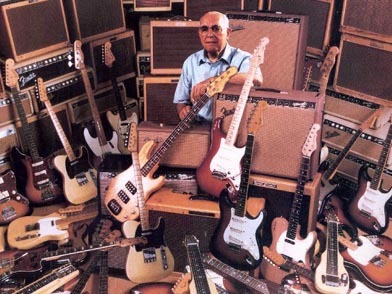On this day in 1909, guitar designer, engineer and inventor Leo Fender was born. Leo would go on to found Fender Electric Instrument Manufacturing Company, now known as Fender Musical Instruments Corporation, and later founded MusicMan and G&L Musical Products (G&L Guitars). His guitar, bass, and amplifier designs from the 1940s continue to dominate popular music more than half a century later.
Leo Fender didn’t invent the electric guitar, but he certainly revolutionized it. Leo’s flair for guitar design reached its pinnacle with his work on the Telecaster, the Precision Bass and, most famously, the Stratocaster, the musical instrument that was the central force in defining rock ‘n’ roll in the 1950s and ’60s, and whose influence continues to dominate every genre of popular music.
An Inventor at Heart
From an early age, Leo showed an interest in tinkering with electronics. When he was 13 years old, his uncle, who ran an automotive-electric shop, sent him a box filled with discarded car radio parts, and a battery. The following year, Leo visited his uncle’s shop in Santa Maria, California, and was fascinated by a radio his uncle had built from spare parts and placed on display in the front of the shop. Leo later claimed that the loud music coming from the speaker of that radio made a lasting impression on him. Soon thereafter, Leo began repairing radios in a small shop in his parents’ home.
After college, Fender took a job as a deliveryman for Consolidated Ice and Cold Storage Company in Anaheim, where he later was made the bookkeeper. It was around this time that a local band leader approached Leo, asking him if he could build a public address system for use by the band at dances in Hollywood. Fender was contracted to build six of these PA systems.
In 1933, Fender met Esther Klosky, and they were married in 1934. About that time, Leo took a job as an accountant for the California Highway Department in San Luis Obispo. In a depression government change-up, Leo’s job was eliminated, and he then took a job in the accounting department of a tire company. After working there six months, Leo lost his job along with the other accountants in the company.
Business Beginnings
Fender recognized the potential for an electric guitar that was easy to hold, easy to tune, and easy to play. He also recognized that players needed guitars that would not feed back at dance hall volumes as the typical arch top would. In addition, Fender sought a tone that would command attention on the bandstand and cut through the noise in a bar. By 1949, he had begun working in earnest on what became the first Telecaster (originally called the Broadcaster) at the Fender factory in Fullerton, California.
Leo Fender’s Legacy
A friendly, modest and unassuming man (his “coffee mug” was a styrofoam cup with the word “Leo” inked on it), he had the lifelong admiration and devotion of his employees, many of whom have remarked that the best working years of their lives were spent under Leo Fender.
He died March 21, 1991, in Fullerton from complications of Parkinson’s disease. The company which bears his name, Fender Musical Instruments Corporation, is now one of the largest musical instrument conglomerates in the world.
